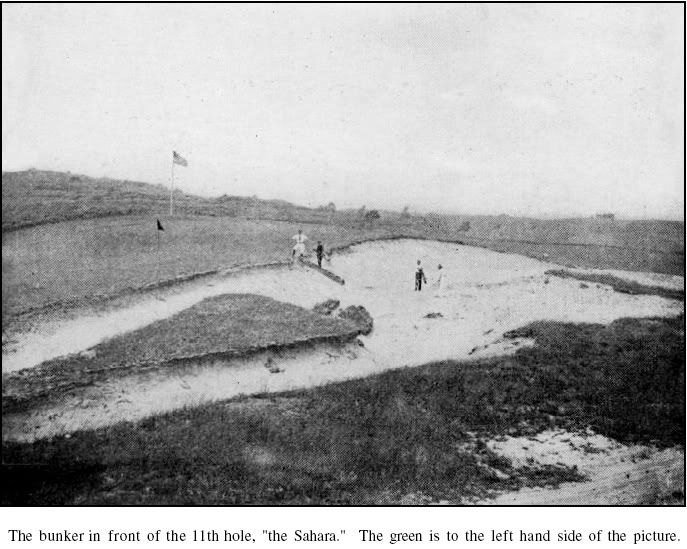Dave,
The black flag has to be the flag in the green, not a directional flag.
I say that for the following reasons.
That flag isn't visible from the tee, it may not even be visible from inside the bunker
Look at the elevation change between the man in the white's head, the top of the bunker, the bottom of the stairs, the head of the fellow in the bunker and the floor of the bunker.
We know that that bunker sits high on the top of the hill, thus that flag is invisible from the tee if the golfer has to traverse the bunker from the tee.
Knowing that the land to the right falls off sharply, that flag wouldn't be visible to anyone hitting a second shot.
And, why would anyone place a directional flag in the middle of a green or fairway for approach shots of 50 to 100 yards.
And, if I go to the aerial, your bottom photo in post # 340, you locate that "directional" flag right in the middle of the fairway, a fairway that can clearly be seen from the tee. Hence, there's NO NEED to have a directional flag there because the entire fairway is visible to the golfer as he stands on the tee within the footpad of the 1st green.
In addition, on your aerial, you've got that black flag 30 to 40 yards distant from the edge of the bunker.
In the 1920 photo it's barely 5 yards from the edge of the bunker.
The other item of note is the following.
Look at the black flag in the 1910 photo.
Look at how the land behind it, starting at its base in the ground, right up to the top of the flag, rises sharply.
There is NO land that rises like that on top of that hill, where you've positioned the black flag in your "google"aerial.
Again, the land forms don't match.
Please measure from the 2nd tee, within the right side of the 1st green, to the black flag in your google aerial.
If you're familiar with the topography in that area, as you stand at the base of the windmill/watertower, or up inside it, looking west or WNW, the land does NOT rise up like it does in your photo. The "high" side of the bunker is NOT to the right, it's to the left.
Yet, the photo shows just the opposite
The landform, where you indicate the American and Black flags are, doesn't fit the landform in the photo.

If, the black flag is in fact the "green" flag, there is no terrain flanking or behind that green that bears any remote resemblance to the terrain on top of that hill, as you've depicted. The topo's where your black and American flags are positioned don't match.
TEPaul,
The building in the backround is NOT the clubhouse
The clubhouse is much farther to the right, much closer to the windmill and a far more substantial building.
If this was a photo of #2, that structure would have to be the pro shop next to # 1 tee or a building on Saban's property, but, it's most definitely not the clubhouse.